Emerging Trends and New Developments in Disaster Research after the 2008 Wenchuan Earthquake
Abstract
1. Introduction
2. Methods
2.1. Data Collection
2.2. CiteSpace
2.2.1. Analysis of Co-Cited References
2.2.2. Dual-Map Overlay Analysis
2.2.3. Burst Detection Analysis
2.2.4. Geospatial Distribution with Google Earth
3. Results
3.1. Empirical Characteristics of Publications
3.2. Emerging Trends and New Developments (1999–2017)
3.2.1. Subject Categories with Citation Burst
3.2.2. Keywords with Citation Burst
3.2.3. Landmark Articles of Co-Cited References
(1) “Disaster” Topic
(2) “Disaster & China” Topic
(3) “Wenchuan Earthquake” Topic
3.2.4. Interdisciplinary Level with Dual-Map Overlays
(1) “Disaster” Topic
(2) “Disaster & China” Topic
(3) “Wenchuan Earthquake” Topic
4. Conclusions
Author Contributions
Funding
Acknowledgments
Conflicts of Interest
References
- Guha-Sapir, D.; Hoyosi, P.; Wallemacq, P.; Below, R. Annual Disaster Statistical Review 2016: The Numbers and Trends; Centre for Research on the Epidemiology of Disasters (CRED): Brussels, Belgium, 2017. [Google Scholar]
- Brinkley, D.; Brewer, K. The great deluge: Hurricane Katrina, New Orleans, and the Mississippi Gulf Coast; Harper Perennial: New York, NY, USA, 2006; p. 108. [Google Scholar]
- Wu, J.; Li, N.; Hallegatte, S.; Shi, P.; Hu, A.; Liu, X. Regional indirect economic impact evaluation of the 2008 Wenchuan Earthquake. Environ. Earth Sci. 2012, 65, 161–172. [Google Scholar] [CrossRef]
- Lay, T.; Ammon, C.J.; Kanamori, H.; Xue, L.; Kim, M.J. Possible large near-trench slip during the 2011 M. w 9.0 off the Pacific coast of Tohoku Earthquake. Earth Planets Space 2011, 63, 32. [Google Scholar] [CrossRef]
- Frigerio, I.; Ventura, S.; Strigaro, D.; Mattavelli, M.; De Amicis, M.; Mugnano, S.; Boffi, M. A GIS-based approach to identify the spatial variability of social vulnerability to seismic hazard in Italy. Appl. Geogr. 2016, 4, 12–22. [Google Scholar] [CrossRef]
- Kossin, J.P.; Emanuel, K.A.; Camargo, S.J. Past and projected changes in western North Pacific tropical cyclone exposure. J. Clim. 2016, 29, 5725–5739. [Google Scholar] [CrossRef]
- Meng, Y. Study on the Global Economic Impact of Large-Scale Natural Disasters. Ph.D. Thesis, Beijing Normal University, Beijing, China, 2017. [Google Scholar]
- Shi, P. Disaster Risk Science; Beijing Normal University Published Group: Beijing, China, 2016; ISBN 978-7-303-21754-0. [Google Scholar]
- Urabe, J.; Nakasizuka, T. Ecological Impacts of Tsunamis on Coastal Ecosystems; Springer: Sendai, Japan, 2016; ISBN 978-4-431-56446-1. [Google Scholar]
- Mohr, C.H.; Manga, M.; Wang, C.Y.; Korup, O. Regional changes in streamflow after a megathrust earthquake. Earth Planet. Sci. Lett. 2017, 458, 418–428. [Google Scholar] [CrossRef]
- Sheikhbardsiri, H.; Yarmohammadian, M.H.; Rezaei, F.; Maracy, M.R. Rehabilitation of vulnerable groups in emergencies and disasters: A systematic review. WJEM. 2017, 8, 253. [Google Scholar] [CrossRef] [PubMed]
- Otto, C.; Willner, S.N.; Wenz, L.; Frieler, K.; Levermann, A. Modeling loss-propagation in the global supply network: The dynamic agent-based model acclimate. J. Econ. Dyn. Control 2017, 83, 232–269. [Google Scholar] [CrossRef]
- Dai, F.C.; Xu, C.; Yao, X.; Xu, L.; Tu, X.B.; Gong, Q.M. Spatial distribution of landslides triggered by the 2008 Ms 8.0 Wenchuan earthquake, China. J. Asian Earth Sci. 2011, 40, 883–895. [Google Scholar] [CrossRef]
- Fan, X.; Juang, C.H.; Wasowski, J.; Huang, R.; Xu, Q.; Scaringi, G.; van Westen, C.J.; Havenith, H.B. What we have learned from the 2008 Wenchuan Earthquake and its aftermath: A decade of research and challenges. Eng. Geol. 2018, 241, 25–32. [Google Scholar] [CrossRef]
- Chen, C.; Ibekwe-Sanjuan, F.; Hou, J. The structure and dynamics of cocitation clusters: A multiple-perspective cocitation analysis. J. Assoc. Inf. Sci. Technol. 2010, 61, 1386–1409. [Google Scholar] [CrossRef]
- Van Eck, N.J.; Waltman, L. Software survey: VOSviewer, a computer program for bibliometric mapping. Scientometrics 2010, 84, 523–538. [Google Scholar] [CrossRef] [PubMed]
- Batagelj, V.; Mrvar, A. Pajek-program for large network analysis. Connections 1998, 21, 47–57. [Google Scholar]
- Van Eck, N.J.; Waltman, L. CitNetExplorer: A new software tool for analyzing and visualizing citation networks. J. Informetr. 2014, 8, 802–823. [Google Scholar] [CrossRef]
- Chen, C.; Leydesdorff, L. Patterns of connections and movements in dual-map overlays: A new method of publication portfolio analysis. J. Am. Socr. Inf. Sci. Technol. 2014, 65, 334–351. [Google Scholar] [CrossRef]
- Zhu, J.; Hua, W. Visualizing the knowledge domain of sustainable development research between 1987 and 2015: A bibliometric analysis. Scientometrics 2017, 110, 893–914. [Google Scholar] [CrossRef]
- Chen, C.; Dubin, R.; Kim, M.C. Emerging trends and new developments in regenerative medicine: A scientometric update (2000–2014). Expert. Opin. Biol. Th. 2014, 14, 1295–1317. [Google Scholar] [CrossRef] [PubMed]
- Yin, Z.; Chen, D.; Li, B. Global regulatory t-cell research from 2000 to 2015: A bibliometric analysis. PLoS ONE 2016, 11, e0162099. [Google Scholar]
- Zhu, Y.; Kim, M.C.; Chen, C. An Investigation of the Intellectual Structure of Opinion Mining Research. Available online: http://www.informationr.net/ir/22-1/paper739.html (accessed on 20 December 2018).
- Hu, K.; Qi, K.; Guan, Q.; Wu, C.; Yu, J.; Qing, Y.; Zheng, J.; Wu, H.; Li, X. A scientometric visualization analysis for night-time light remote sensing research from 1991 to 2016. Remote Sens. 2017, 9, 802. [Google Scholar] [CrossRef]
- Kleinberg, J. Bursty and hierarchical structure in streams. Data Min. Knowl. Disc. 2003, 7, 373–397. [Google Scholar] [CrossRef]
- Li, J.; Chen, C.M. CiteSpace: Texting Ming and Visualization in Scientific Literature, 2nd ed.; Capital University of Economics and Business Press: Beijing, China, 2017; ISBN 978-7-5638-2683-4. [Google Scholar]
- Chen, C. Holistic sense-making: Conflicting opinions, creative ideas, and collective intelligence. Libr. Tech 2007, 25, 311–327. [Google Scholar] [CrossRef]
- Norris, F.H.; Friedman, M.J.; Watson, P.J. 60,000 disaster victims speak: Part II. Summary and implications of the disaster mental health research. Psychiatry 2002, 65, 240–260. [Google Scholar] [CrossRef] [PubMed]
- Galea, S.; Nandi, A.; Vlahov, D. The epidemiology of post-traumatic stress disorder after disasters. Epidemiol. Rev. 2005, 27, 78–91. [Google Scholar] [CrossRef] [PubMed]
- Altay, N.; Green, W.G., III. OR/MS research in disaster operations management. Eur. J. Oper. Res. 2006, 175, 475–493. [Google Scholar] [CrossRef]
- Mileti, D. Disasters by Design: A Reassessment of Natural Hazards in the United States; Joseph Henry Press: Washington, DC, USA, 1999; ISBN 978-0-309-06360-9. [Google Scholar]
- Turner, B.L.; Kasperson, R.E.; Matson, P.A.; McCarthy, J.J.; Corell, R.W.; Christensen, L.; Eckely, N.; Kasperson, J.X.; Luers, A.; Martello, M.L.; et al. A framework for vulnerability analysis in sustainability science. PNAS 2003, 100, 8074–8079. [Google Scholar] [CrossRef] [PubMed]
- Cutter, S.L.; Boruff, B.J.; Shirley, W.L. Social vulnerability to environmental hazards. Soc. Sci. Quart. 2003, 84, 242–261. [Google Scholar] [CrossRef]
- Blaikie, P.; Cannon, T.; Davis, I.; Wisner, B. At risk: Natural Hazards, People’s Vulnerability and Disasters; Routledge: Abingdon, UK, 2004. [Google Scholar]
- Adger, W.N. Vulnerability. Glob. Environ. Change 2006, 16, 268–281. [Google Scholar] [CrossRef]
- Bruneau, M.; Chang, S.E.; Eguchi, R.T.; Lee, G.C.; O’Rourke, T.D.; Reinhorn, A.M.; Shinozuka, M.; Tierney, K.; Wallace, W.A.; Von Winterfeldt, D. A framework to quantitatively assess and enhance the seismic resilience of communities. Earthq. Spectra 2003, 19, 733–752. [Google Scholar] [CrossRef]
- Cutter, S.L.; Barnes, L.; Berry, M.; Burton, C.; Evans, E.; Tate, E.; Webb, J. A place-based model for understanding community resilience to natural disasters. Glob. Environ. Chang. 2008, 18, 598–606. [Google Scholar] [CrossRef]
- Norris, F.H.; Stevens, S.P.; Pfefferbaum, B.; Wyche, K.F.; Pfefferbaum, R.L. Community resilience as a metaphor, theory, set of capacities, and strategy for disaster readiness. Am. J. Commun. Psychol. 2008, 41, 127–150. [Google Scholar] [CrossRef]
- Brewin, C.R.; Andrews, B.; Valentine, J.D. Meta-analysis of risk factors for posttraumatic stress disorder in trauma-exposed adults. J. Consult. Clin. Psychol. 2000, 68, 748. [Google Scholar] [CrossRef]
- Galea, S.; Ahern, J.; Resnick, H.; Kilpatrick, D.; Bucuvalas, M.; Gold, J.; Vlahov, D. Psychological sequelae of the September 11 terrorist attacks in New York City. N. Engl. J. Med. 2002, 346, 982–987. [Google Scholar] [CrossRef] [PubMed]
- Schuster, M.A.; Stein, B.D.; Jaycox, L.H.; Collins, R.L.; Marshall, G.N.; Elliott, M.N.; Zhou, A.J.; Kanouse, D.E.; Morrison, J.L.; Berry, S.H. A national survey of stress reactions after the September 11, 2001, terrorist attacks. N. Engl. J. Med. 2001, 345, 1507–1512. [Google Scholar] [CrossRef] [PubMed]
- Norris, F.H.; Friedman, M.J.; Watson, P.J.; Byrne, C.M.; Diaz, E.; Kaniasty, K. 60,000 disaster victims speak: Part, I. An empirical review of the empirical literature, 1981–2001. Psychiatry 2000, 65, 207–239. [Google Scholar] [CrossRef]
- Barbarosoǧlu, G.; Arda, Y. A two-stage stochastic programming framework for transportation planning in disaster response. J. Opera Res. Soc. 2004, 55, 43–53. [Google Scholar] [CrossRef]
- Özdamar, L.; Ekinci, E.; Küçükyazici, B. Emergency logistics planning in natural disasters. Ann. Oper Res. 2004, 129, 217–245. [Google Scholar] [CrossRef]
- Sheu, J.B. An emergency logistics distribution approach for quick response to urgent relief demand in disasters. Transp. Res. E-Log. 2007, 43, 687–709. [Google Scholar] [CrossRef]
- Mete, H.O.; Zabinsky, Z.B. Stochastic optimization of medical supply location and distribution in disaster management. Int. J. Prod. Econ. 2010, 126, 76–84. [Google Scholar] [CrossRef]
- Rawls, C.G.; Turnquist, M.A. Pre-positioning of emergency supplies for disaster response. Transp. Res. B-Meth. 2010, 44, 521–534. [Google Scholar] [CrossRef]
- Sheu, J.B. Dynamic relief-demand management for emergency logistics operations under large-scale disasters. Transp. Res. E-Log. 2010, 46, 1–17. [Google Scholar] [CrossRef]
- Yi, W.; Özdamar, L. A dynamic logistics coordination model for evacuation and support in disaster response activities. Eur. J. Opera Res. 2007, 179, 1177–1193. [Google Scholar] [CrossRef]
- Yin, Y.; Wang, F.; Sun, P. Landslide hazards triggered by the 2008 Wenchuan earthquake, Sichuan, China. Landslides 2009, 6, 139–152. [Google Scholar] [CrossRef]
- Tang, C.; Zhu, J.; Li, W.L.; Liang, J.T. Rainfall-triggered debris flows following the Wenchuan earthquake. Bull.~Eng. Geol. Environ. 2009, 68, 187–194. [Google Scholar] [CrossRef]
- Cui, P.; Chen, X.-Q.; Zhu, Y.-Y.; Su, F.-H.; Wei, F.-Q.; Han, Y.S.; Liu, H.-J.; Zhuang, J.-Q. The Wenchuan earthquake (May 12, 2008), Sichuan province, China, and resulting geohazards. Nat. Hazards 2011, 56, 19–36. [Google Scholar] [CrossRef]
- Wang, L.; Zhang, Y.; Wang, W.; Shi, Z.; Shen, J.; Li, M.; Xin, Y. Symptoms of posttraumatic stress disorder among adult survivors three months after the Sichuan earthquake in China. J. Trauma. Stress 2009, 22, 444–450. [Google Scholar] [CrossRef] [PubMed]
- Xu, J.; Song, X. Posttraumatic stress disorder among survivors of the Wenchuan earthquake 1 year after: Prevalence and risk factors. Compr. Psychiatry 2011, 52, 431–437. [Google Scholar] [CrossRef] [PubMed]
- Fan, F.; Zhang, Y.; Yang, Y.; Mo, L.; Liu, X. Symptoms of posttraumatic stress disorder, depression, and anxiety among adolescents following the 2008 Wenchuan earthquake in China. J. Trauma. Stress 2011, 24, 44–53. [Google Scholar] [CrossRef] [PubMed]
- Zhang, Z.; Shi, Z.; Wang, L.; Liu, M. One year later: Mental health problems among survivors in hard-hit areas of the Wenchuan earthquake. Public Health 2011, 125, 293–300. [Google Scholar] [CrossRef]
- Gorum, T.; Fan, X.; van Westen, C.J.; Huang, R.Q.; Xu, Q.; Tang, C.; Wang, G. Distribution pattern of earthquake-induced landslides triggered by the 12 May 2008 Wenchuan earthquake. Geomorphology 2011, 133, 152–167. [Google Scholar] [CrossRef]
- Burchfiel, B.C.; Royden, L.H.; van der Hilst, R.; Hager, B.H.; Chen, Z.; King, R.W.; Li, C.Y.; Liu, J.; Yao, H.; Kirby, E. A geological and geophysical context for the Wenchuan earthquake of 12 May 2008, sichuan, people’s republic of China. Gsa Today 2008, 18, 4–11. [Google Scholar] [CrossRef]
- Royden, L.H.; Burchfiel, B.C.; van der Hilst, R. The geological evolution of the Tibetan Plateau. Science 2008, 321, 1054–1058. [Google Scholar] [CrossRef]
- Parsons, T.; Ji, C.; Kirby, E. Stress changes from the 2008 Wenchuan earthquake and increased hazard in the Sichuan basin. Nature 2008, 454, 509. [Google Scholar] [CrossRef] [PubMed]
- Wang, W.M.; Zhan, L.F.; Li, J.; Yao, Z.X. Rupture process of the M., 8.0 Wenchuan earthquake of Sichuan, China. Chin. J. Geophys. 2008, 51, 1403–1410. [Google Scholar]
- Hubbard, J.; Shaw, J.H. Uplift of the Longmen Shan and Tibetan plateau, and the 2008 Wenchuan (M = 7.9) earthquake. Nature 2009, 458, 194. [Google Scholar] [CrossRef] [PubMed]
- Zhang, Y.; Feng, W.; Xu, L.; Zhou, C.; Chen, Y. Spatio-temporal rupture process of the 2008 great Wenchuan earthquake. Sci. China Ser. D 2009, 52, 145–154. [Google Scholar] [CrossRef]
- Shen, Z.K.; Sun, J.; Zhang, P.; Wan, Y.; Wang, M.; Bürgmann, R.; Zeng, Y.; Gan, W.; Liao, H.; Wang, Q. Slip maxima at fault junctions and rupturing of barriers during the 2008 Wenchuan earthquake. Nat. Geosci. 2009, 2, 718. [Google Scholar] [CrossRef]
- Liu-Zeng, J.; Zhang, Z.; Wen, L.; Tapponnier, P.; Sun, J.; Xing, X.; Hu, G.; Xu, Q.; Zeng, L.; Ding, L. Co-seismic ruptures of the 12 May 2008, Ms 8.0 Wenchuan earthquake, Sichuan: East–west crustal shortening on oblique, parallel thrusts along the eastern edge of Tibet. Earth Planet. Sci. Lett. 2009, 286, 355–370. [Google Scholar] [CrossRef]
- Lin, A.; Ren, Z.; Jia, D.; Wu, X. Co-seismic thrusting rupture and slip distribution produced by the 2008 Mw 7.9 Wenchuan earthquake, China. Tectonophysics 2009, 471, 203–215. [Google Scholar] [CrossRef]
- Zhang, P.Z.; Wen, X.Z.; Shen, Z.K.; Chen, J.H. Oblique, high-angle, listric-reverse faulting and associated development of strain: The Wenchuan earthquake of May 12, 2008, Sichuan, China. Annu. Rev. Earth Planet. Sci. 2010, 38, 353–382. [Google Scholar] [CrossRef]
- Xu, X.; Wen, X.; Yu, G.; Chen, G.; Klinger, Y.; Hubbard, J.; Shaw, J. Coseismic reverse-and oblique-slip surface faulting generated by the 2008 Mw 7.9 Wenchuan earthquake, China. Geology 2009, 37, 515–518. [Google Scholar] [CrossRef]
- Cui, P.; Zhu, Y.Y.; Han, Y.S.; Chen, X.Q.; Zhuang, J.Q. The 12 May Wenchuan earthquake-induced landslide lakes: Distribution and preliminary risk evaluation. Landslides 2009, 6, 209–223. [Google Scholar] [CrossRef]
- Huang, R.; Li, W.L. Research on development and distribution rules of geohazards induced by Wenchuan earthquake on 12th May, 2008. Chin. J. Rock Mech. Eng. 2008, 27, 2585–2592. [Google Scholar]
- Liu, X.; Zhan, F.B.; Hong, S.; Niu, B.; Liu, Y. A bibliometric study of earthquake research: 1900–2010. Scientometrics 2012, 92, 747–765. [Google Scholar] [CrossRef]
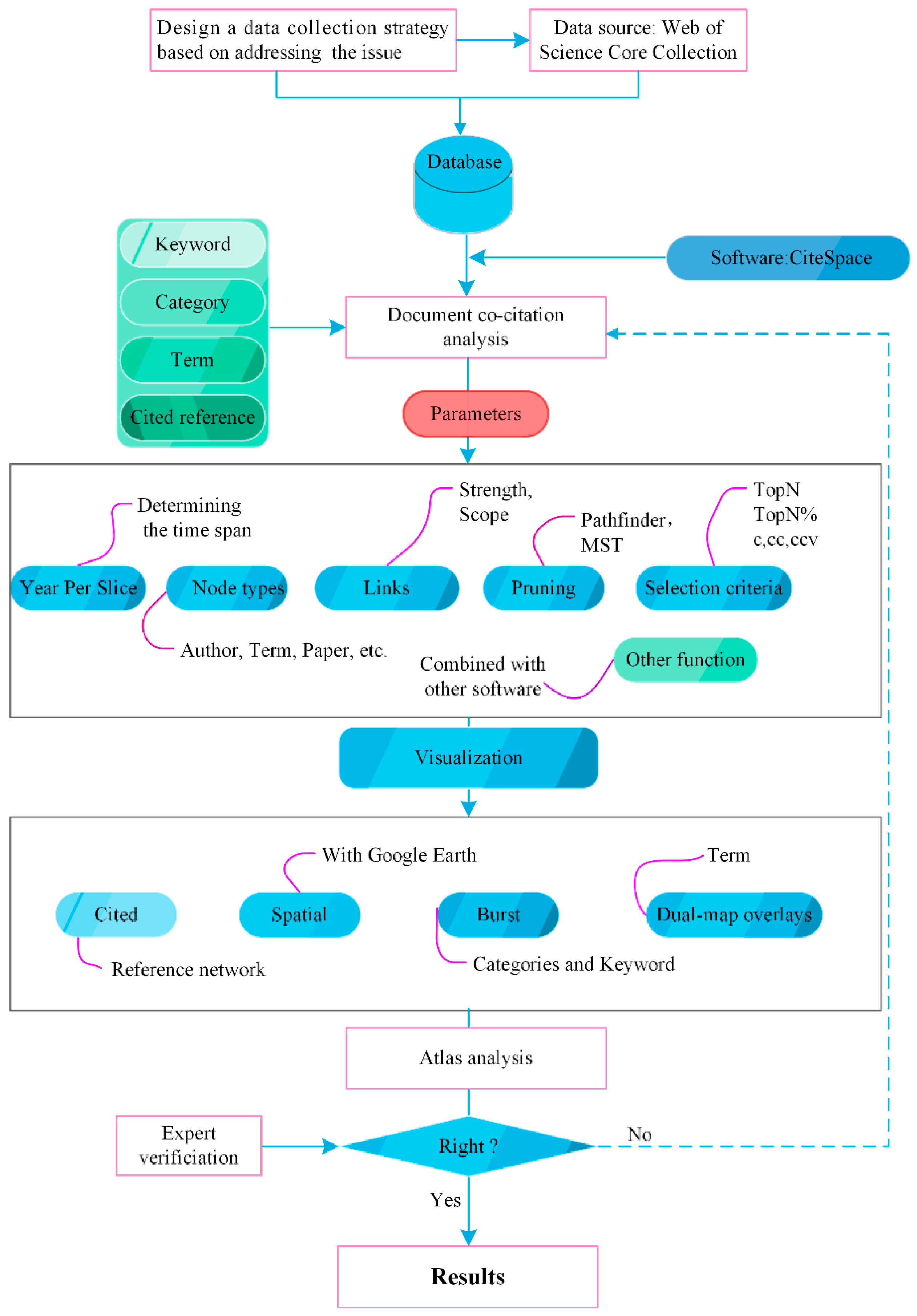
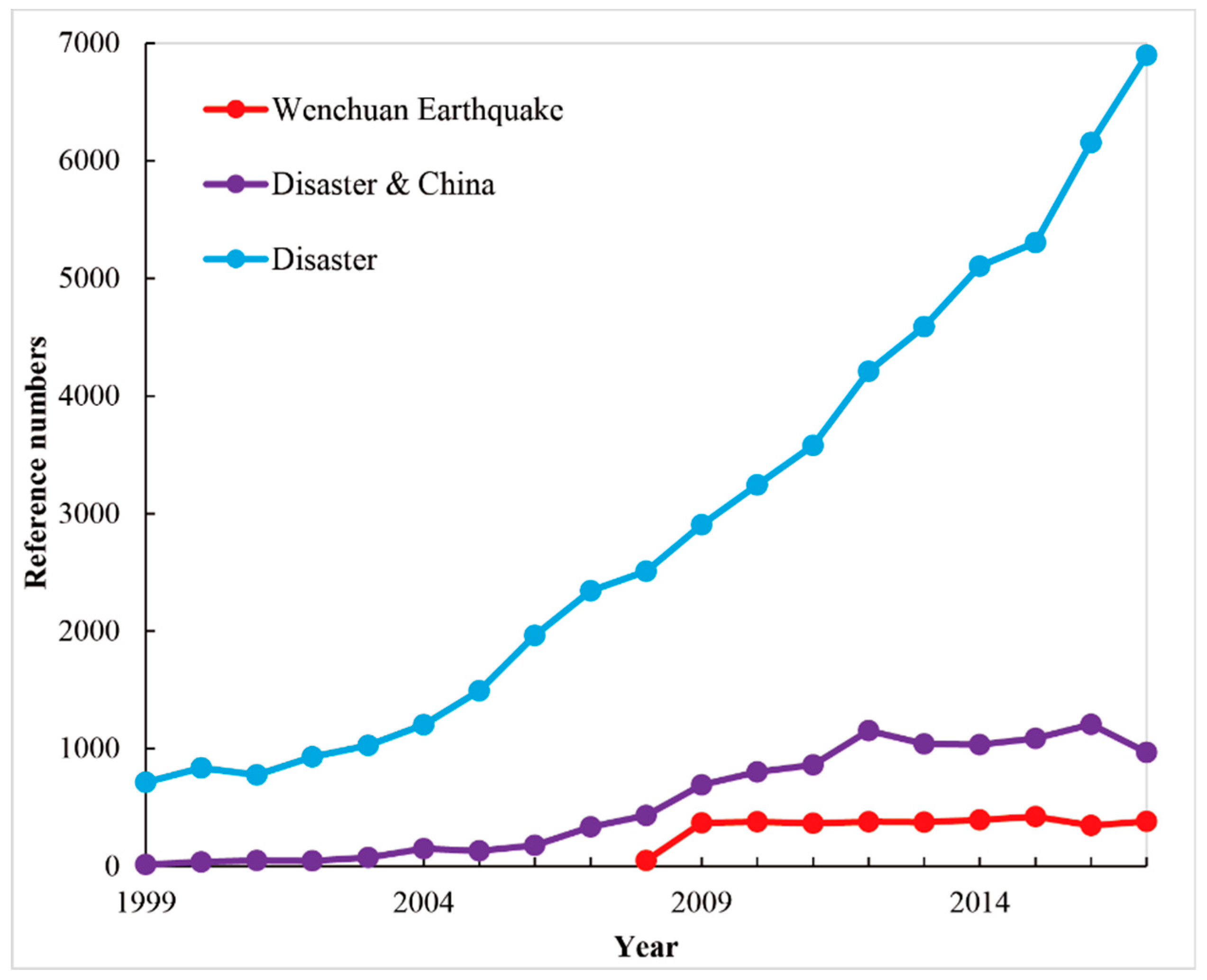
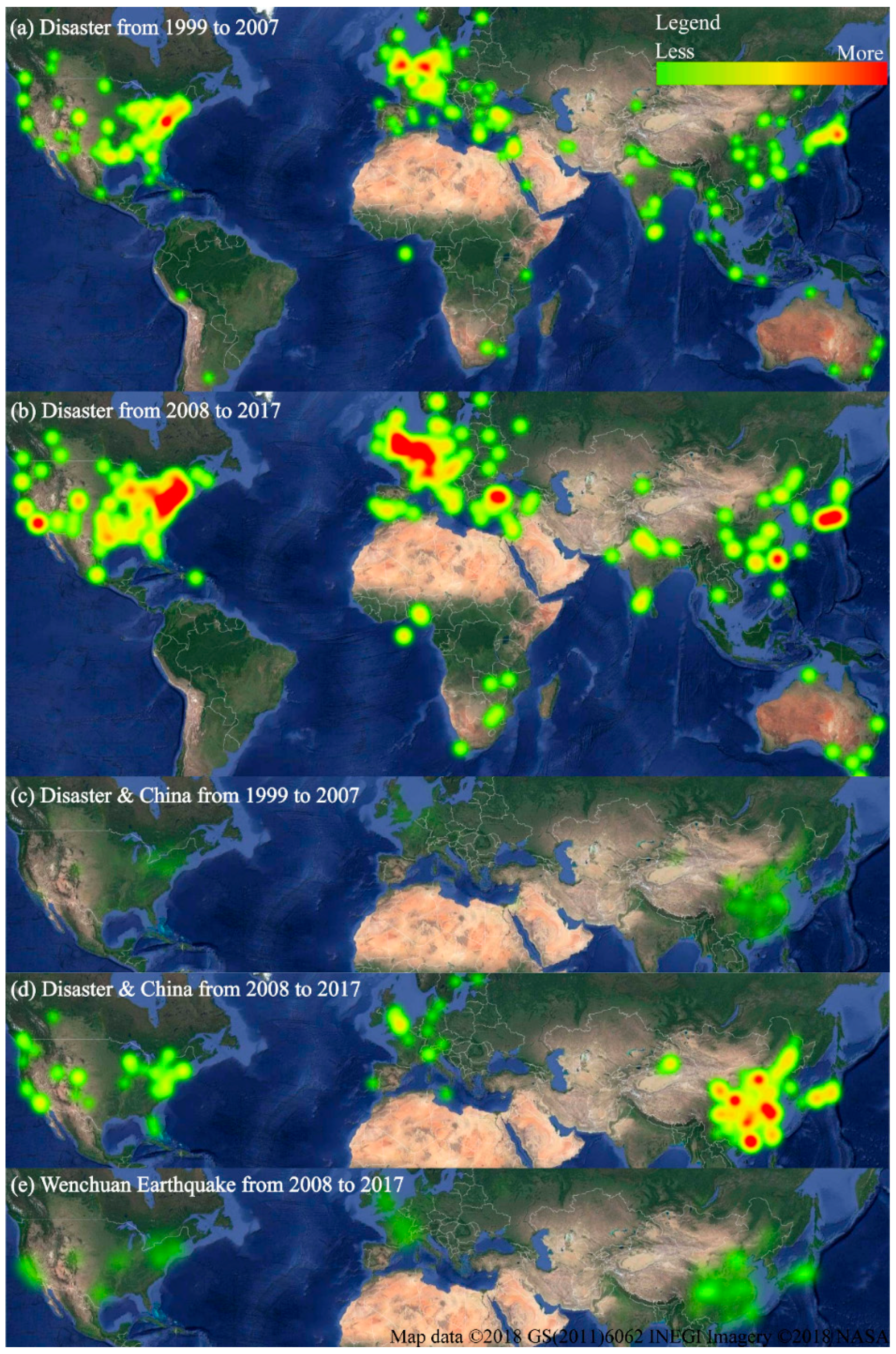

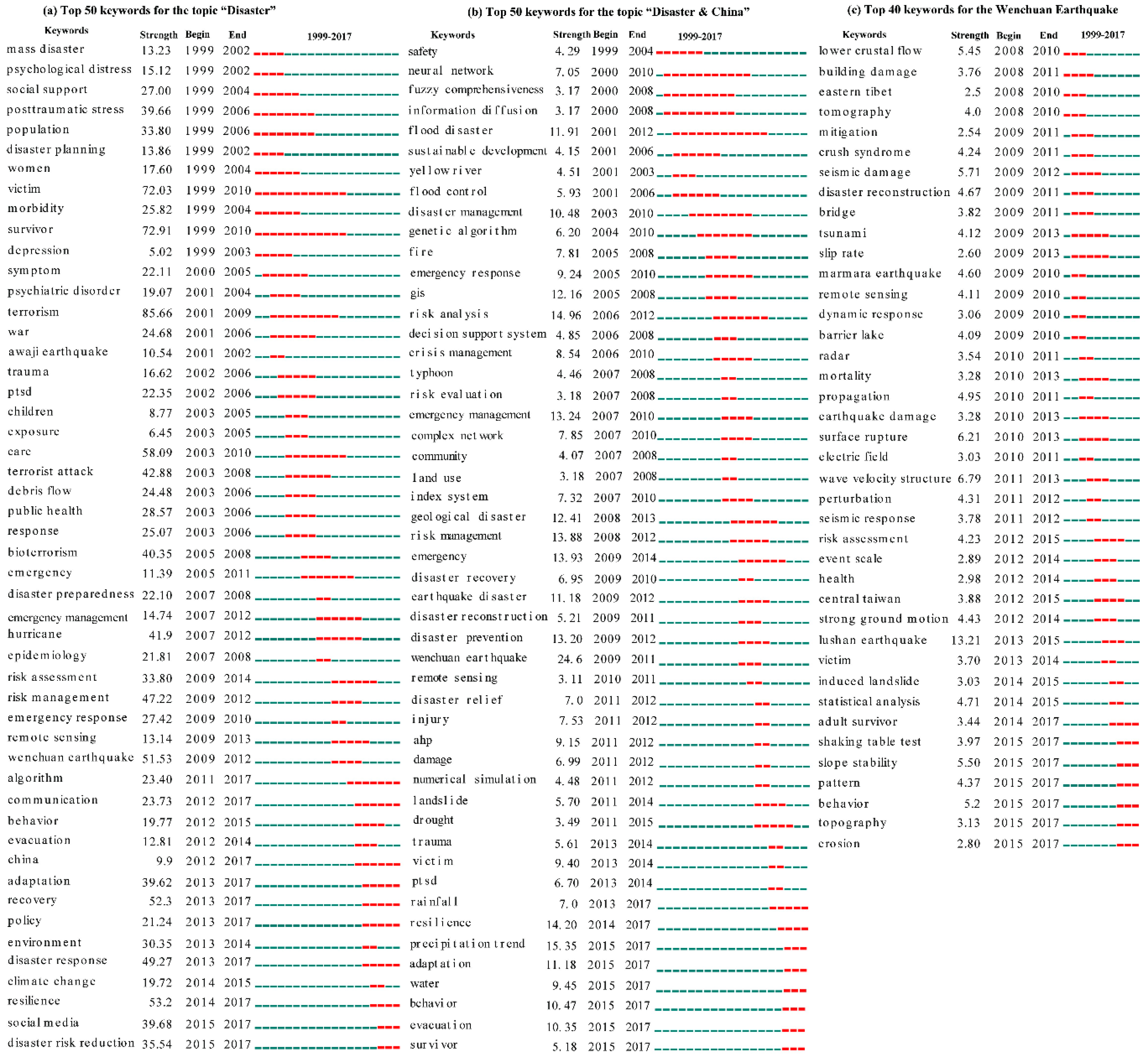
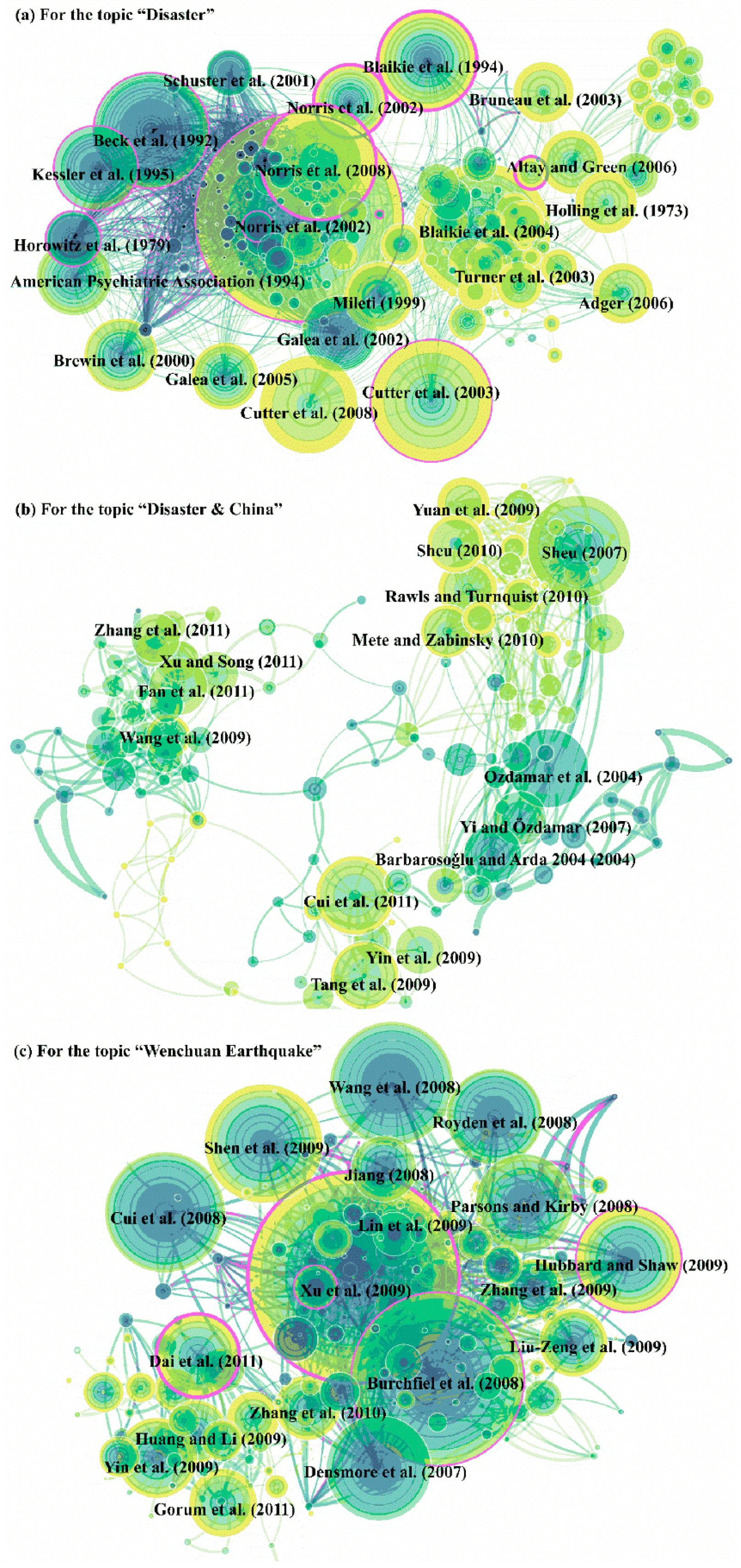
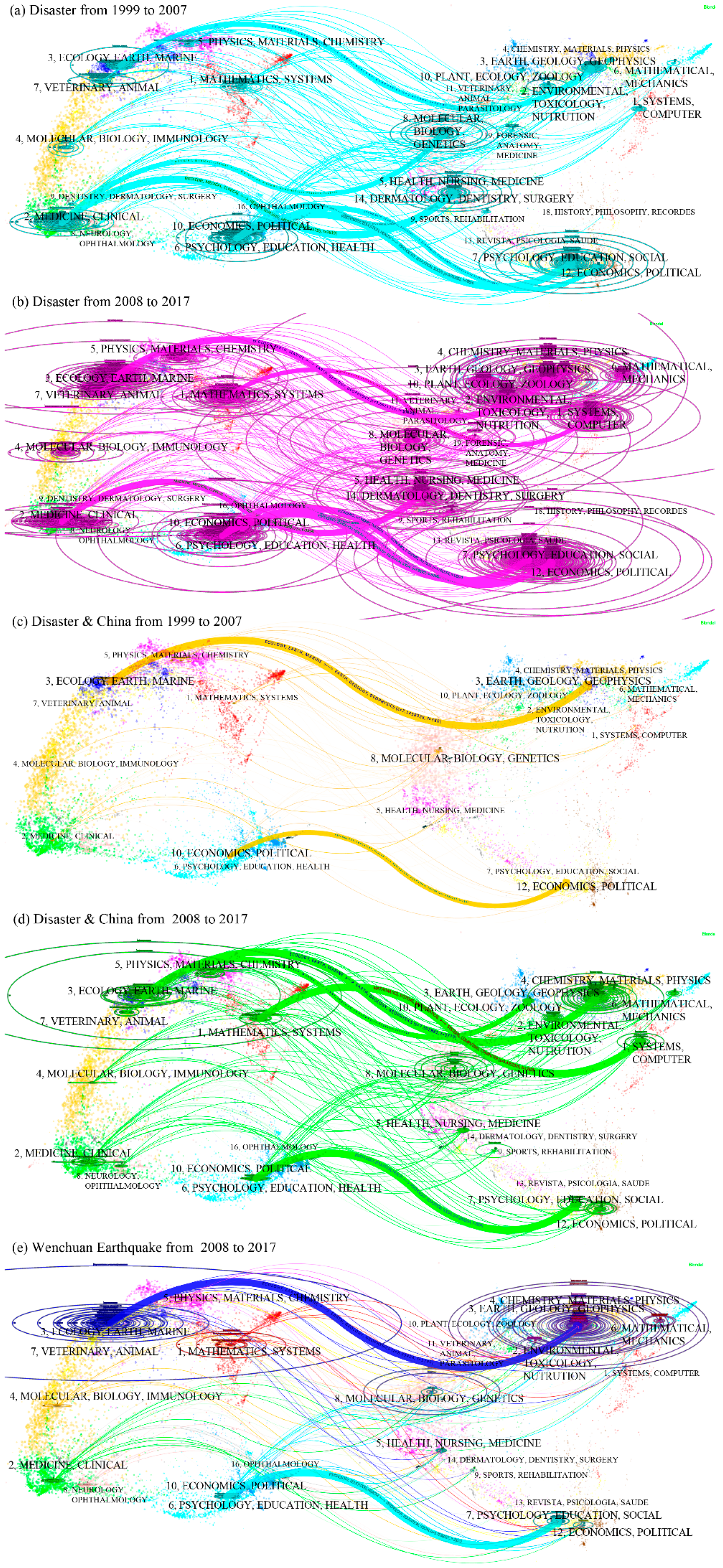
| Dataset | Duration | Records |
|---|---|---|
| Wenchuan Earthquake | 2008–2017 | 3461 |
| Disaster & China | 1999–2007 | 1023 |
| 2008–2017 | 9285 | |
| Disaster | 1999–2007 | 11,292 |
| 2008–2017 | 44,516 |
© 2018 by the authors. Licensee MDPI, Basel, Switzerland. This article is an open access article distributed under the terms and conditions of the Creative Commons Attribution (CC BY) license (http://creativecommons.org/licenses/by/4.0/).
Share and Cite
Wang, C.; Wu, J.; He, X.; Ye, M.; Liu, W.; Tang, R. Emerging Trends and New Developments in Disaster Research after the 2008 Wenchuan Earthquake. Int. J. Environ. Res. Public Health 2019, 16, 29. https://doi.org/10.3390/ijerph16010029
Wang C, Wu J, He X, Ye M, Liu W, Tang R. Emerging Trends and New Developments in Disaster Research after the 2008 Wenchuan Earthquake. International Journal of Environmental Research and Public Health. 2019; 16(1):29. https://doi.org/10.3390/ijerph16010029
Chicago/Turabian StyleWang, Cailin, Jidong Wu, Xin He, Mengqi Ye, Wenhui Liu, and Rumei Tang. 2019. "Emerging Trends and New Developments in Disaster Research after the 2008 Wenchuan Earthquake" International Journal of Environmental Research and Public Health 16, no. 1: 29. https://doi.org/10.3390/ijerph16010029
APA StyleWang, C., Wu, J., He, X., Ye, M., Liu, W., & Tang, R. (2019). Emerging Trends and New Developments in Disaster Research after the 2008 Wenchuan Earthquake. International Journal of Environmental Research and Public Health, 16(1), 29. https://doi.org/10.3390/ijerph16010029







